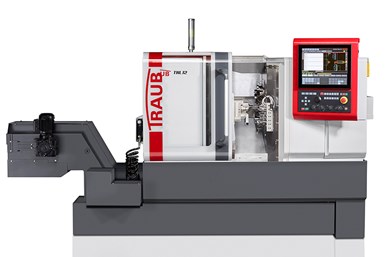Index Corporation Introduces Sliding Headstock CNC Lathe for Small Parts Machining
Index Corporation’s Traub TNL12 sliding headstock lathe features a variety of design changes to boost speed, flexibility and accuracy.
Share







Index Corp.’s Traub TNL12 sliding headstock lathe. Photo Credit: Index Corp.
Index Corporation’s Traub TNL12 sliding headstock lathe for small part machining features a variety of design changes to boost speed, flexibility and accuracy. The machine is said to be well suited for medical manufacturers responsible for producing implants, bone screws and instruments for minimally invasive surgery.
Like its predecessor, the TNL12 features four tool carriers that can be applied to a workpiece simultaneously. While the frontworking attachment and counterspindle were previously arranged on a single slide, they are now housed on separate slides. This is said to eliminate potential interdependence between front-end and counter-spindle machining, enabling greater programming flexibility. The design is also said to reduce the mass of both elements, enabling faster and more dynamic machine response.
While the former model of the machine offered X-axis machining on the counterspindle, the latest TNL12 provides full three-axis machining in this position. A new backworking attachment offers six tool stations, with up to four enabling live tooling, as well as a flushing unit.
Overall tooling capacity has also been increased, with the capability to house up to 40 tools with the use of double and triple holders. This is said to give operators more freedom to optimize machining of highly complex parts. Each of two six-station tool turrets has its own servomotor and interpolated Y-axis, with chip-to-chip tool change times reduced to 0.3 second.
While the previous generation TNL12 used belt drives on the main and counterspindles, the new machine incorporates fluid-cooled motor spindles with a maximum speed of 12,000 rpm. It is also said to offer higher dynamic response because of low-mass clamping cylinders and a carbon sleeve for the guide bushing drive. The guide bushing is freely selectable, live or programmable, with the ability to adjust itself via a pneumatic servo valve.
Related Content
-
Lean Approach to Automated Machine Tending Delivers Quicker Paths to Success
Almost any shop can automate at least some of its production, even in low-volume, high-mix applications. The key to getting started is finding the simplest solutions that fit your requirements. It helps to work with an automation partner that understands your needs.
-
6 Machine Shop Essentials to Stay Competitive
If you want to streamline production and be competitive in the industry, you will need far more than a standard three-axis CNC mill or two-axis CNC lathe and a few measuring tools.
-
How to Determine the Currently Active Work Offset Number
Determining the currently active work offset number is practical when the program zero point is changing between workpieces in a production run.















